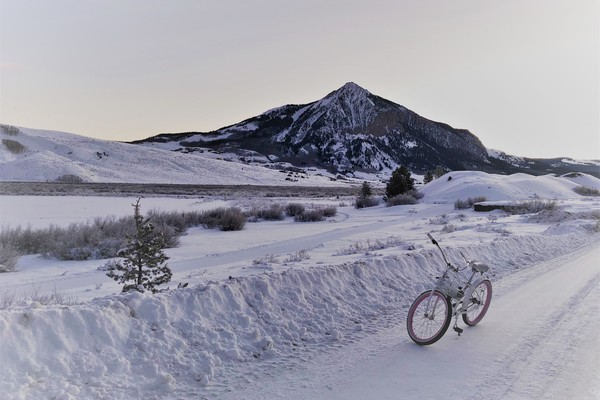Tips for Cycling in the Snow

Tips for Cycling in the Snow
First, for safety, we first recommend that you ride an indoor trainer. If you don’t have a trainer, it is okay to do other indoor cardio activities like treadmill, elliptical, rowing machine or stair-climber.
However, we also know that riding in the snow can be peaceful and magical! If you are adventurous, confident in your bike-handling skills, and find a safe route without traffic, please consider the following snow cycling tips:
- It sounds obvious—be warm! Feet, hands and head are the spots most vulnerable to the cold.
- Wear warm gloves with a bit of grip that allow you to operate your bike. You don’t want your hands to slip off your handlebars. You also need to make sure your gloves allow you to grab the brake levers and click the shifters.
- If you find your fingers going numb, spin your hands like a wind-mill. This will force blood into the tips of your fingers and warm them up.
- Use one-time-use hand warmers, like HotHands. These are excellent to get you started out into the cold until your heart-rate increases and you begin to generate body heat. Apply one on your left wrist underneath your glove to promote the circulation of warm blood throughout your body.
- Be smart and prepare your tires for max traction.
- Avoid skinny road tires, if you can. Use wider tires with a weather tread.
- Reduce the PSI in your tires to increase traction. Lower your PSI to the manufacture’s minimum recommended range. If running tubeless tires, be careful to no go too low and unseat the tire.
- If you have disc brakes and find yourself caught in treacherous environment, secure the zip ties around your tires as a plastic tread. To do this, start with a single zip tie, fix it to the tire, cut off the excess tie, and then spin your tire to test for clearance. This is especially important if your bike has fenders. If it is clear, secure the remaining zip ties.
- If you live in a very snowy area, you consider in investing in studded snow tires for bicycling.
- Go slow. Braking, turning and responding to hazards takes more time.
- Remain as level as possible. Hitting a slippery patch at an angle will cause you to spill.
- You will go where you look. Always keep your head up, looking down the road and pedaling at a reasonably-high cadence when possible. Forward motion and looking where you want to go will get you past most road hazards. Looking down and staring at the ground just before your front tire can take you down.
- When going uphill in slick areas keep your weight centered on your saddle or toward the back of the bike. This will help keep your back tire from spinning out.
- If you attempt to climb up or descend an icy slope and can't get purchase, use your bike like an ice-axe. Lay it on its non-drive side and use the street-down peddle to chop into the ice. Then use your body-weight to auger the pedal into the ice. Only do this if necessary as it could damage your non-drive side pedal and handlebar.
- Cars are even more scary and unpredictable in snowy weather. Poor visibility and traction amplify the danger.
- Assume that the driver cannot either stop or see you. Frost and snow on windows create a very dangerous world of blind-spots.
- Avoid areas where cars are struggling for traction.
- NEVER turn in front of a car, even if it appears to be going slow or gives you a hand-wave to go in front of them. A tiny tap on their rear bumper by another car combined with a spill on black ice in front of them could cause the vehicle to slide into you.
- Avoid ice at all costs and watch out for other slippery hazards like road sand and salt.
- It if looks wet and the temperature has been below freezing within the last four hours, treat it like ice.
- Snow and ice can hide hidden obstacles you’d normally see like rocks, sticks, uneven pavement, potholes and drainage grates.
- Snow that has not been driven on and is not compacted is usually the best traction available on a road after a snow-storm.
- Ride on the un-tracked snow, avoiding the previously-created tracks in the snow.
- Crunchy snow means traction, if you don't hear the crunch under your tires while upon either a white or wet-looking surface, assume you are on ice and use extreme caution.
Big thanks to Dangerous Dave Anolik for his photo and snow cycling tips!
Home